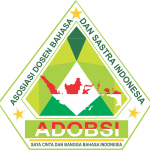MODELING OF COVID-19 TOPICS ON PUBLIC HEALTH MESSAGE COMMUNICATION PATTERNS ON RADAR BANYUMAS SOCIAL MEDIA
Abstract
Keywords
Full Text:
PDFReferences
Abrams, T. (2020). Disability, deadly discourse, and collectivity amid coronavirus (COVID-19). Scandinavian Journal of Disability Research, 22(1), 168–174. https://doi.org/10.16993/SJDR.732
Ameli, M., Esfandabadi, Z. S., Sadeghi, S., Ranjbari, M., & Zanetti, M. (2022). COVID-19 and Sustainable Development Goals (SDGs): Scenario analysis through fuzzy cognitive map modeling. Gondwana Research, 14(1), 138-155. https://doi.org/10.1016/j.gr.2021.12.014
Bonefasius, R. dkk. (2020). Elipsis pada wacana tentang covid-19 dalam kolom Opini surat kabar Kompas. Jurnal Pendidikan dan kebudayaan Miissio, 12(2), 152–163. https://doi.org/10.36928/jpkm.v12i2.580
Buigut, S., & Kapar, B. (2021). Covid-19 cases, media attention and social mood. International Journal of Economics and Financial Issues, 11(4), 66-72. https://doi.org/10.32479/ijefi.11591
Chandrasekaran, R., Mehta, V., Valkunde, T., & Moustakas, E. (2020). Topics, trends, and sentiments of tweets about the COVID-19 pandemic: Temporal infoveillance study. Journal of Medical Internet Research, 22(10), 1-12, https://doi.org/10.2196/22624
Chen, E., Lerman, K., & Ferrara, E. (2020). Tracking social media discourse about the covid-19 pandemic: Development of a public coronavirus twitter data set. JMIR Public Health and Surveillance, 6(2), 1-9. https://doi.org/10.2196/19273
Chew, C., & Eysenbach, G. (2009). Pandemics in the age of Twitter: Content analysis of Tweets during the 2009 H1N1 outbreak. PLoS ONE, 5(11), 1-13. https://doi.org/10.1371/journal.pone.0014118
Garcia, K., & Berton, L. (2020). Topic detection and sentiment analysis in Twitter content related to COVID-19 from Brazil and the USA. Applied Soft Computing, 101, 107057. https://doi.org/10.1016/j.asoc.2020.107057
Gustomy, R. (2020). Pandemi ke Infodemi: Polarisasi Politik dalam Wacana Covid-19 Pengguna Twitter. JIIP: Jurnal Ilmiah Ilmu Pemerintahan, 5(2), 190-205. https://doi.org/10.14710/jiip.v5i2.8781
Hosseini, P., Hosseini, P., & Broniatowski, D. A. (2020). Content analysis of Persian/Farsi Tweets during COVID-19 pandemic in Iran using NLP. In Proceedings of the 1st Workshop on NLP for COVID-19 (Part 2) at EMNLP 2020, Online. Association for Computational Linguistics. https://doi.org/10.18653/v1/2020.nlpcovid19-2.26
Ito, H., & Chakraborty, B. (2020). Social Media Mining with Dynamic Clustering: A Case Study by COVID-19 Tweets. 2020 11th International Conference on Awareness Science and Technology (iCAST), 1–6. https://doi.org/10.1109/iCAST51195.2020.9319496
Kwok, S. W., Vadde, S. K., & Wang, G. (2021). Tweet Topics and Sentiments Relating to COVID-19 Vaccination Among Australian Twitter Users: Machine Learning Analysis. Journal of Medical Internet Research, 23(5), 1-16. https://doi.org/10.2196/26953
Liu, Q., Zheng, Z., Zheng, J., Chen, Q., Liu, G., Chen, S.,& Ming, W. (2020). Health Communication Through News Media During the Early Stage of the COVID-19 Outbreak in China: Digital Topic Modeling Approach. Journal of Medical Internet Research, 22(4), 1-12. https://doi.org/10.2196/19118
Lwin, M., Lu, J., Sheldenkar, A., Schulz, P., Shin, W., Gupta, R., & Yang, Y. (2020). Global Sentiments Surrounding the COVID-19 Pandemic on Twitter: Analysis of Twitter Trends. JMIR Public Health and Surveillance, 6(2), 1-10. https://doi.org/10.2196/19447
Majumder, M. S., & Mandl, K. D. (2020). Early in the epidemic: impact of preprints on global discourse about COVID-19 transmissibility. The Lancet Global Health, 8(5), e627–e630. https://doi.org/10.1016/S2214-109X(20)30113-3
Marcoux, T., & Agarwal, N. (2021). Narrative Trends of COVID-19 Misinformation. Diambil dari https://www.semanticscholar.org/paper/0709e03af0787bdd1cf6cad724283f9097e75a2a
Medford, R., Saleh, S., Sumarsono, A., Perl, T., & Lehmann, C. U. (2020). An “Infodemic”: Leveraging High-Volume Twitter Data to Understand Early Public Sentiment for the Coronavirus Disease 2019 Outbreak. Open Forum Infectious Diseases, 7. https://doi.org/10.1093/ofid/ofaa258
Muchtar, K., Bahrudin, B., & Khoyin, M. (2020). Analisis Tajuk Rencana Mengenai Covid 19 pada Harian Umum Pikiran Rakyat. 1–14. Diambil dari http://digilib.uinsgd.ac.id/id/eprint/31611
Mutanga, M. B., & Abayomi, A. (2020). Tweeting on COVID-19 pandemic in South Africa: LDA-based topic modelling approach. African Journal of Science, Technology, Innovation and Development, 14, 163–172. https://doi.org/10.1080/20421338.2020.1817262
Nur, M. (2020). Konstruksi Reputasi dan Responsitivitas Intansi Pemerintah melalui Media Sosial pada Situasi Pandemi Covid-19 (Analisis Wacana pada Laman Facebook Direktorat Jenderal Perbendaharaan Kementerian Keuangan RI). 5, 217–234.
Ortega, J., & Bernabé-Moreno, J. (2021). Modelling the Degree of Emotional Concern: COVID-19 Response in Social Media. Applied Sciences, 11(9),38-72. https://doi.org/10.3390/app11093872
Prajarto, N. (2021). A Content Analysis on Health Communication of Covid-19 in Online Media From February To July 2021. Jurnal Penelitian Komunikasi dan Opini Publik, 25(2), 132–148. https://doi.org/10.33299/jpkop.25.2.3544
Scannell, D. (2021). COVID-19 Vaccine Discourse on Twitter: A Content Analysis of Persuasion Techniques, Sentiment and Mis/Disinformation. Journal of Health Communication, 26(7), 443–459. https://doi.org/10.1080/10810730.2021.1955050
Sha, H., Hasan, M., Mohler, G., & Brantingham, P. (2020). Dynamic Topic Modeling of the COVID-19 Twitter Narrative Among U.S. Governors and Cabinet Executives. ArXiv, abs/2004.1. Diambil dari https://www.semanticscholar.org/paper/e767d7dc7a215fc7e1eed093425089a179eba77a
Xue, J., Chen, J., Chen, C., Zheng, C., Li, S., & Zhu, T. (2020). Public discourse and sentiment during the COVID 19 pandemic: Using Latent Dirichlet Allocation for topic modeling on Twitter. PLoS ONE, 15(1), 1-12. https://doi.org/10.1371/journal.pone.0239441
Yanti, A. D. dkk. (2020). Analisis Kesalahan Berbahasa dalam Wacana Media Sosial Lawan Covid-19. Journal Humanities Piktorial, 2(2), 1-8, http://dx.doi.org/10.32493/piktorial.v2i2.7643
Yin, H., Yang, S., & Li, J. (2020). Detecting Topic and Sentiment Dynamics Due to COVID-19 Pandemic Using Social Media. in Advanced Data Mining and Applications (ADMA 2020). Lecture Notes in Computer Science, vol 12447. https://doi.org/10.1007/978-3-030-65390-3_46
Refbacks
- There are currently no refbacks.






